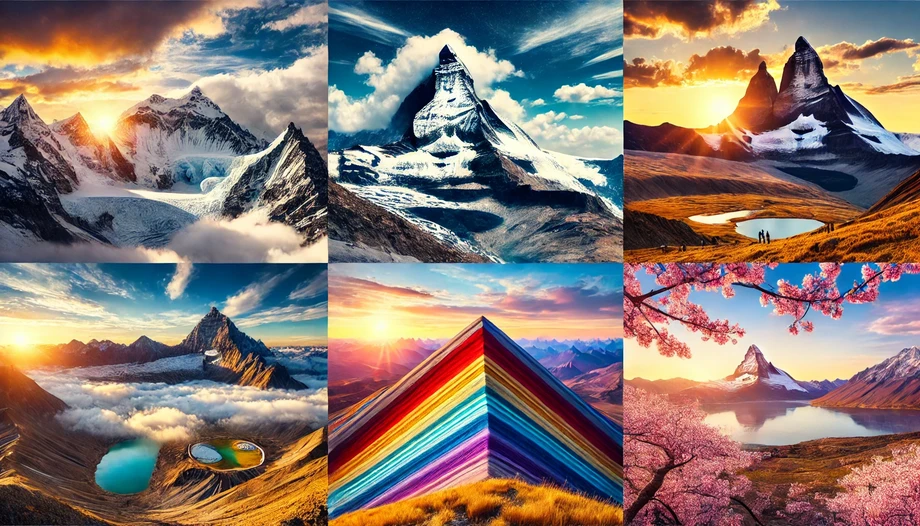H1: The Best Mountains of the World
H2: Introduction to the World’s Best Mountains
Mountains, with their breathtaking heights and serene beauty, are some of the most fascinating natural wonders on Earth. From towering peaks that touch the skies to colorful hills shaped by nature's artistry, mountains have inspired explorers, adventurers, and dreamers for centuries.
H3: Why Mountains Are Magnificent Natural Wonders
Mountains aren't just geological formations—they are symbols of endurance and majesty. Their massive presence impacts weather patterns, nurtures unique ecosystems, and serves as natural borders for countries. For thrill-seekers, mountains are a canvas of adventure; for spiritual souls, they are a source of peace and introspection.
H3: The Importance of Mountains in Culture, Adventure, and Nature
Across civilizations, mountains have been revered as sacred entities. From the myths of Mount Olympus to the spiritual significance of Mount Kailash, they’ve been the backdrop of countless tales. Beyond culture, they provide a playground for outdoor activities like hiking, skiing, and rock climbing, as well as being the origin of many vital rivers.
H2: The Himalayas – Home to the Tallest Peaks
The Himalayas, spanning five countries, are home to some of the highest and most famous peaks in the world.
H3: Mount Everest: The Roof of the World
Standing at 8,848 meters (29,029 feet), Mount Everest is Earth's highest point above sea level. Located on the border of Nepal and China, Everest attracts climbers from across the globe, each yearning to conquer its formidable heights. Its snow-covered slopes and extreme conditions make it a challenge even for the most experienced mountaineers.
H3: Kanchenjunga: The Five Treasures of Snow
Located on the India-Nepal border, Kanchenjunga is the third-highest mountain globally. Known as the "Five Treasures of Snow," it symbolizes prosperity in Tibetan culture. Unlike Everest, Kanchenjunga remains less crowded, offering pristine beauty and tranquility for trekkers.
H2: The Alps – Europe’s Majestic Playground
Europe’s Alps are famed for their accessibility and stunning alpine scenery.
H3: Matterhorn: Switzerland’s Iconic Pyramid
With its perfectly triangular shape, the Matterhorn is one of the most recognizable mountains in the world. Standing at 4,478 meters, it towers over Zermatt, Switzerland, and has become a dream destination for climbers and photographers alike.
H3: Mont Blanc: The Highest Peak in the Alps
At 4,807 meters, Mont Blanc is the tallest mountain in Western Europe. Straddling the border of France and Italy, it’s a hub for skiing, snowboarding, and mountaineering. The surrounding region is also renowned for its luxury resorts and stunning trails.
H2: The Andes – Spine of South America
The Andes stretch over 7,000 kilometers along the western edge of South America, making them the world’s longest mountain range.
H3: Aconcagua: The Sentinel of the Andes
At 6,961 meters, Aconcagua in Argentina is the highest mountain outside of Asia. It is a magnet for climbers seeking a high-altitude challenge without the technical difficulties posed by the Himalayas.
H3: Vinicunca: The Rainbow Mountain of Peru
A stark contrast to the icy peaks, Vinicunca’s vibrant, colorful stripes are caused by its mineral-rich soil. It has become an Instagram-worthy spot, drawing thousands of visitors annually.
H2: The Rockies – North America’s Iconic Range
The Rocky Mountains stretch from Canada to New Mexico, offering a diverse array of landscapes.
H3: Mount Elbert: The Highest in the Rockies
Located in Colorado, Mount Elbert rises to 4,401 meters. It’s known for its relatively gentle slopes, making it an achievable summit for beginner hikers.
H3: Banff National Park Peaks: A Winter Wonderland
The jagged peaks of Banff National Park in Canada are a winter paradise. From Lake Louise to Moraine Lake, these snow-capped wonders offer unparalleled beauty year-round.
Africa’s Peaks – Mountains of Mystery and Beauty
Africa’s mountains are as diverse as its landscapes, offering unique ecosystems and captivating vistas.
H3: Mount Kilimanjaro: The Roof of Africa
Standing at 5,895 meters, Mount Kilimanjaro is the highest mountain in Africa. Located in Tanzania, it is a dormant volcano with three cones—Kibo, Mawenzi, and Shira. Known for its accessible trekking routes, Kilimanjaro is one of the most climbed peaks in the world. Its stunning transformation from lush rainforests at the base to the snow-covered summit creates a journey like no other.
H3: Mount Kenya: A Lesser-Known Gem
Mount Kenya, Africa’s second-highest peak, stands at 5,199 meters. Its rugged summits, Batian and Nelion, challenge seasoned climbers, while its lower slopes offer picturesque hikes through alpine meadows and bamboo forests. Declared a UNESCO World Heritage site, it is a symbol of Kenya’s natural beauty.
H2: Asia’s Other Treasures Beyond the Himalayas
Asia’s mountains extend beyond the mighty Himalayas, offering some of the most iconic and culturally significant peaks.
H3: Mount Fuji: Japan’s Sacred Icon
Mount Fuji, Japan's tallest peak at 3,776 meters, is more than just a mountain—it is a cultural treasure. Revered in Shinto and Buddhist traditions, its symmetrical cone has inspired countless artists and poets. Climbing Fuji is a spiritual pilgrimage for many, especially during the summer months when trails are open to the public.
H3: Mount Kinabalu: The Crown of Borneo
Rising to 4,095 meters, Mount Kinabalu in Malaysia is Southeast Asia’s tallest peak. Known for its biodiversity, it hosts unique species like the rafflesia flower. The climb, though challenging, rewards trekkers with panoramic views and the thrill of reaching Low's Peak at sunrise.
H2: Australia and Oceania – Unique Mountain Wonders
The mountains of Australia and Oceania are a mix of modest heights and extraordinary beauty.
H3: Mount Kosciuszko: Australia’s Highest Peak
Mount Kosciuszko, standing at 2,228 meters, is Australia’s tallest mountain. Located in New South Wales, it offers accessible hiking trails with breathtaking views of the surrounding Snowy Mountains. While it may not be as towering as other peaks, its cultural and historical significance in Australia is profound.
H3: Mauna Kea: A Hawaiian Marvel
Mauna Kea in Hawaii is unique—it is the tallest mountain in the world when measured from its base on the ocean floor, towering over 10,000 meters. Above sea level, its summit at 4,207 meters offers one of the best stargazing experiences globally, thanks to its clear skies and remote location.
H2: The Antarctic Mountains – Surreal and Untouched
Antarctica's mountains are among the least explored, shrouded in ice and mystery.
H3: Mount Vinson: The Highest in Antarctica
Mount Vinson, standing at 4,892 meters, is the tallest peak in Antarctica. Its remote location and extreme weather make it a challenge for even the most experienced climbers. Despite its isolation, it offers a pristine and otherworldly experience for adventurers.
H3: Sentinel Range: A Land of Ice and Peaks
The Sentinel Range, part of the Ellsworth Mountains, features dramatic ice-covered peaks and glaciers. It is one of the few places on Earth where untouched wilderness reigns, offering a glimpse into a world frozen in time.
H2: Exploring the Spiritual and Cultural Significance
Mountains are more than just geographical features—they hold deep cultural and spiritual meaning for many communities.
H3: Mountains in Mythology and Religion
From Mount Olympus in Greece to Mount Kailash in Tibet, peaks have been considered homes of gods and places of pilgrimage. For example, the ancient Greeks believed Mount Olympus was the dwelling of Zeus and other deities, while Hindus and Buddhists regard Mount Kailash as sacred.
H3: Cultural Traditions and the Peaks
Many mountain communities have unique traditions tied to their surroundings. Festivals, rituals, and storytelling often revolve around the peaks, emphasizing their importance in shaping identities and heritage.
H2: Top Hiking Destinations for Adventure Seekers
For adventurers, the world’s mountains offer countless trails to explore.
H3: Everest Base Camp: The Ultimate Trek
The journey to Everest Base Camp is a bucket-list item for trekkers. This iconic route takes adventurers through Sherpa villages, Buddhist monasteries, and jaw-dropping landscapes, culminating in views of the mighty Everest.
H3: The Inca Trail: Journey to Machu Picchu
Peru’s Inca Trail is a historic hike that leads to the ancient city of Machu Picchu. Along the way, trekkers encounter stunning mountain scenery, cloud forests, and archaeological sites, making it a once-in-a-lifetime experience.
H2: Mountains and Biodiversity
Mountain ecosystems are home to some of the planet’s most unique flora and fauna.
H3: Unique Flora and Fauna of Mountain Regions
Mountains nurture diverse life forms, from snow leopards in the Himalayas to unique alpine flowers in the Alps. These ecosystems thrive despite harsh climates, showcasing nature's adaptability.
H3: The Role of Mountains in Global Ecosystems
Mountains act as water towers, supplying fresh water to millions. They also regulate climate and serve as refuges for endangered species, making their conservation critical for the planet’s health.
H2: How to Plan a Mountain Adventure
Proper planning is essential for any mountain expedition.
H3: Essential Gear for Mountain Hikes
From sturdy boots to weather-appropriate clothing, having the right gear can make or break your mountain experience. Other essentials include a reliable map, first-aid kit, and enough food and water.
H3: Safety Tips for Mountain Explorations
Always check weather conditions before starting your hike, inform someone about your itinerary, and never underestimate the altitude. Acclimatization and hydration are crucial for high-altitude treks.
H2: Challenges of Preserving Mountain Ecosystems
As human activities increase, mountains face growing threats.
H3: Climate Change and Melting Glaciers
Global warming has led to rapidly melting glaciers, threatening water supplies and mountain habitats. Peaks like Kilimanjaro have seen drastic reductions in their ice caps, raising concerns for future generations.
H3: Conservation Efforts and Responsible Tourism
Efforts like eco-tourism and conservation projects aim to minimize human impact on mountains. Visitors are encouraged to follow Leave No Trace principles and support sustainable practices.
H2: Conclusion: Celebrating the Peaks of the Planet
Mountains stand as timeless symbols of nature’s grandeur, inspiring awe and respect.
H3: Why Mountains Will Always Inspire
Whether it’s their towering presence or the adventures they promise, mountains have a way of captivating our hearts and minds. They remind us of our place in the world and the beauty that lies beyond our everyday lives.
H3: A Call to Explore and Protect These Natural Wonders
As you explore the mountains of the world, remember to cherish and protect them. These peaks are not just destinations; they are legacies for future generations to enjoy.
FAQs
What is the most famous mountain in the world?
Mount Everest is arguably the most famous mountain due to its height and global recognition.What are the tallest mountain ranges on each continent?
Each continent boasts a notable range, like the Himalayas in Asia, the Andes in South America, and the Rockies in North America.How do mountains form?
Mountains form primarily through tectonic activities like the collision of plates or volcanic activity.What’s the best mountain for beginner climbers?
Mount Kilimanjaro in Tanzania is an excellent option due to its non-technical trails.Are there mountains still undiscovered?
While most large peaks are mapped, smaller and remote ranges in regions like Antarctica remain unexplored.- for best travel deals to visit these magnificent mountains click here


Post a Comment